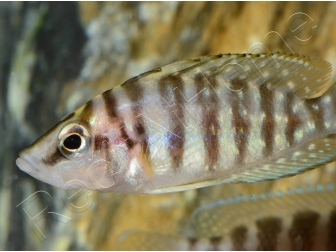- Out-of-Stock

|
|
|
|
|
|
|
|
|
|
Native to Central Africa, the Altolamprologus calvus has vertical brown stripes on beige or even silver scales. Living in pairs in slow-moving and stagnant waters, this fish is piscivorous. Roaming rocky floors, an environment with dark hiding places is highly recommended.
Fish native to Central Africa, the Altolamprologus calvus has vertical brown stripes on beige or even silver scales. In its natural environment, it lives in basic water. The pH should therefore be between 7.8 and 9. The suitable water temperature ranges from 23° to a maximum of 29°.
Roaming rocky-laden grounds, this fish evolves in stagnant and slow-moving waters in search of food. Decorations with rocks and structures that provide shade to the tank are therefore recommended. Furthermore, the Altolamprologus calvus is a piscivorous species. Although not very territorial, it is still less tolerant with its kind, especially with females. Easily stressed, this fish shows its discomfort by developing black spots on its body. Therefore, it is necessary to regularly monitor their scales.

Native to Central Africa, the Altolamprologus calvus has vertical brown stripes on beige or even silver scales. Living in pairs in slow-moving and stagnant waters, this fish is piscivorous. Roaming rocky floors, an environment with dark hiding places is highly recommended.
check_circle
check_circle




